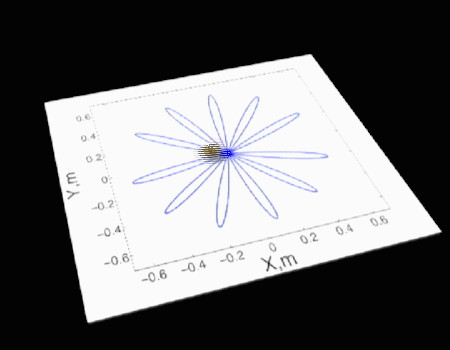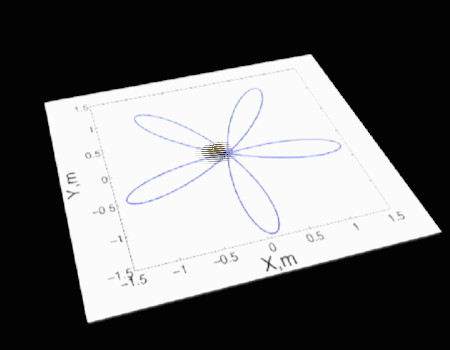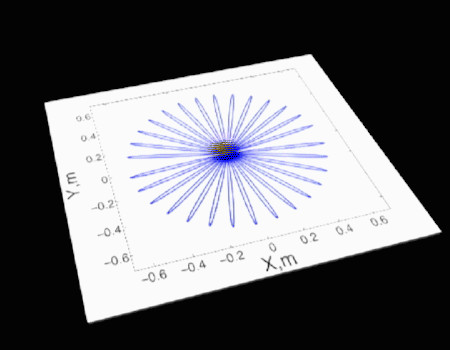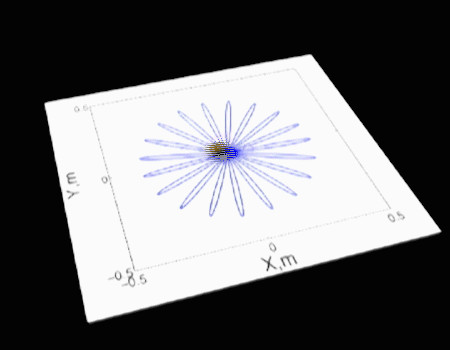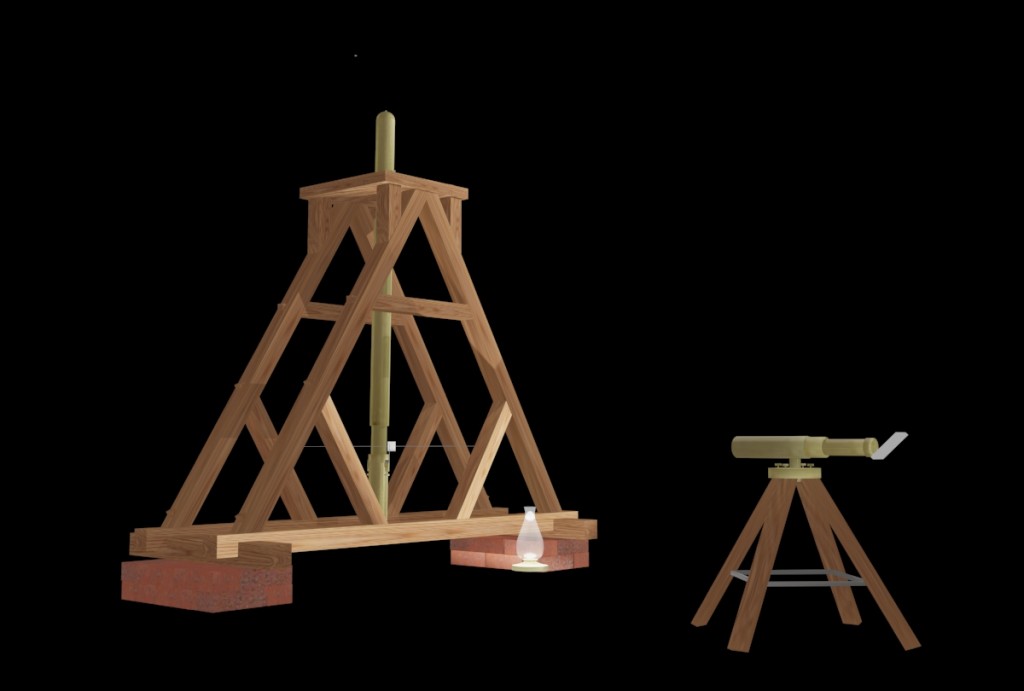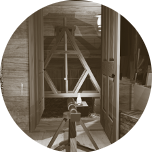Kater's Pendulum
Learn how to Play with this Interactive Exhibit
Measuring Gravity at Fort Conger in the First International Polar Year (IPY) 1882-83
Edward Israel knew that every object in the universe attracts every other object; this phenomenon is called gravitation and the force of attraction is commonly known as gravity. In the case of our planet earth, (terrestrial) gravity is the force of attraction between the earth and an object on, below or above the surface of the earth. Because the earth is an oblate spheroid, being slightly flattened at the poles due to the earth’s rotation, the gravitational force at the equator is slightly less than the gravitational force at the poles. Is it possible to measure the differences that such changes in latitude produce in the force of gravity?
The answer to this question is “Yes.” Swinging a pendulum and timing its regular motion allowed Israel and other IPY scientists to measure gravity.
How Pendulums Work
A Foucault pendulum is a simple pendulum consisting of a heavy weight attached to a string or wire of a specified length that swings freely about its axis. If you pull it back and let it complete one swing in only one direction, the pendulum draws a straight line. Like this:
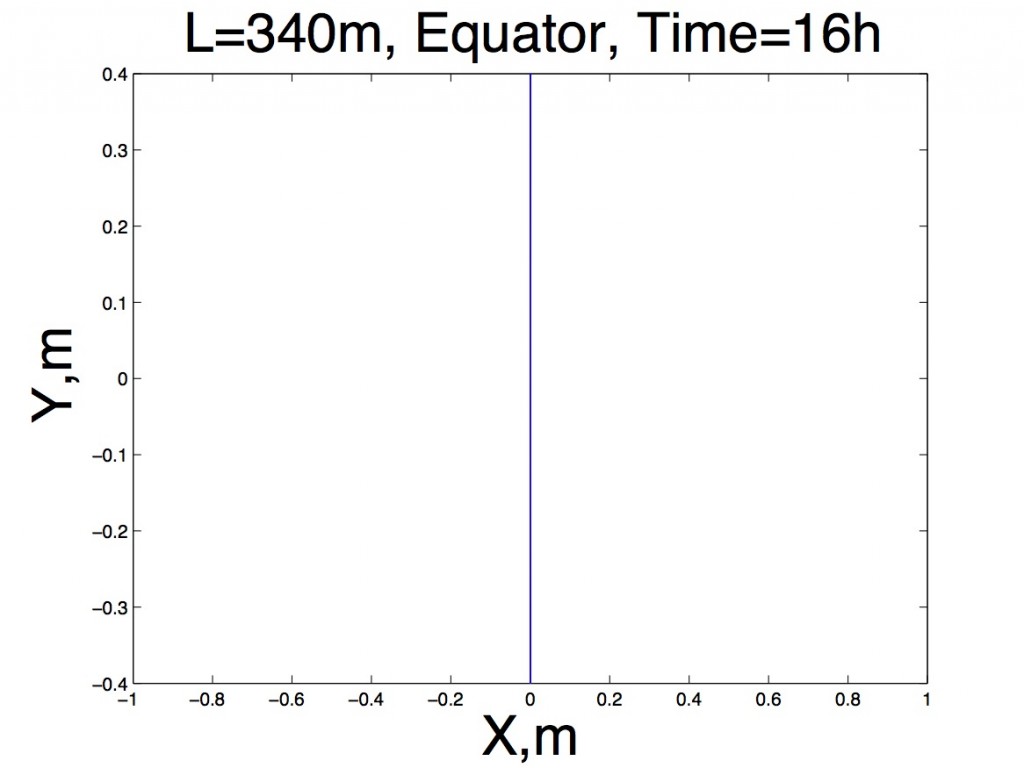 The movement of a Foucault pendulum at the Earth’s equator, where rotation has no effect on its movement.
The movement of a Foucault pendulum at the Earth’s equator, where rotation has no effect on its movement.
If you allow a Foucault pendulum to swing back and forth repeatedly, you notice that the line it draws looks like a series of overlapping ellipses. Like this:
Why would your pendulum move in a straight line during one swing, but follow a more circular path when travelling back and forth?
Remarkably, the answer is that the pendulum is still swinging in a straight line! It only seems like the pendulum is swinging in a circular motion because the earth is rotating below it.
The direction of the earth’s rotation varies, depending upon whether you are north or south of the equator. If we swing our pendulum in the Arctic (northern hemisphere), its circular movement will be clockwise. If we swing it in the Antarctic (southern hemisphere), its circular movement will be counter clockwise.
The Mechanics of Pendulum Movement
We now examine how three factors affect the movement of Foucault pendulums. These are: A) Pendulum Length; B) Rate of Rotation; and C) Force of Gravity.
A) Pendulum Length. The pendulum on the left is 680m long, while the one on the right is 1360m long pendulum (such exaggerated pendulum lengths make it easier to detect how they move). What effect do longer and shorter lengths have on how the pendulum moves?
(Answer: the user observes that the period of oscillation speeds up as the string gets shorter, and slows down when it gets longer).
B) Rate of Rotation: A pendulum that is motionless will hang straight up and down. In contrast, a pendulum in motion will appear to swing in a circular to elliptical pattern because the earth rotates below it. Since the speed at which the earth rotates varies based on latitude, the radius of the ellipses produced by our pendulum’s movement will vary depending on where we are located on earth. For example, the speed at the North Pole is almost zero, while the speed at the equator is about 1,670km per hour.
The pendulum on the left has been swung on Earth at Latitude 23 degrees while the one on the right has been swung at a latitude of 81 degrees. What effect does latitude have on how the pendulum moves?
(Answer: Increasing latitude equates with increasing rotation. As the rate of rotation increases, there are fewer ellipses but each ellipse has a larger radius.
C) Force of Gravity: When you pull a pendulum back, the force of gravity pulls it in the opposite direction. The gravitational force between an object and the earth varies by latitude because the earth’s rotation has the effect of slightly flattening its shape near the poles. Consequently, an object will weigh slightly more at the poles where gravitational force is stronger, than it will at the equator where gravitational force is comparatively weaker. However, latitudinal differences in the force of gravity are subtle and difficult to detect. Let's explore the relationship between force of gravity and pendulum movement by swinging our pendulum on the Earth, where the force of gravity = 9.8 m/s2; the Moon where the force of gravity = 1.626 m/s2; and Jupiter where the force of gravity = 23.167 m/s2. To make our observations comparable, let’s also swing our pendulum at 81 degrees latitude on each of these celestial bodies. How does the force of gravity affect the pendulum’s movement?
(Answer: By comparing the animations of pendulum movement on Earth, Jupiter, and the Moon, the user observes that as the force of gravity increases, pendulum speed increases, the radius of each ellipse increases, and the ellipses become more numerous).
Measuring Gravity at Fort Conger
The Foucault pendulum is a freely swinging weight suspended from a pivot. Calculating the force of gravity at Fort Conger requires a pendulum that is swung on a single horizontal axis called a compound or Kater's pendulum. Timing how long it takes a compound pendulum to complete a full left and a full right swing (a period) and using the equation:

where T12 and T22 are the observed periods of oscillation and h1 and h2 define the pendulum’s centre of mass (G), allowing one to calculate the force of gravity (g) experienced at a specific location, such as Fort Conger.
Pendulum Observations at Fort Conger
Scientists during the 19th century believed that if enough pendulums were swung at enough latitudes, the resulting gravity measurements could be used to calculate the shape of the earth to a greater level of accuracy. This was one of the reasons for the gravimetric survey work completed at Fort Conger by expedition astronomer Edward Israel. The survey used a pendulum provided by the US Coast Survey called the Peirce No. 1, named for its designer Charles S. Peirce. Peirce instructed Israel in its use before the expedition. The pendulum was then packed in a long wooden case, sealed with tin, and carried north on the expedition ship in 1881. The Peirce No. 1 pendulum was used to determine the value of (g) at Fort Conger, a determination that would be used to assist in calculating the oblateness (shape) of the earth. Similar pendulum observations were to be carried out at other IPY stations throughout the Arctic.
During the first winter at Fort Conger, a concrete base was poured to create a stable platform for the pendulum. The platform was then enclosed within a lean-to structure built on the north side of the house. A snow wall was then erected around the structure to help regulate temperature, as well as eliminate drafts that might affect the pendulum’s motion. A door or window was built into the north wall of the house so that measurements could be recorded without having to enter the lean-to, thereby preserving the ambient temperature and humidity of the interior. The Peirce No. 1 was taken out of its case and hung from its frame inside the structure.
Operation of the Peirce No. 1 was a demanding task. The pendulum was swung for 90 minutes then reversed and swung again for a further 30 minutes, both swings to be within a very specific and narrow range of motion between 0.005 and 0.0025 of the pendulum’s arc radius. This procedure was repeated many times over six hours each day. Expansion and contraction of the metal pendulum caused by temperature changes would affect the period of oscillations. Consequently, thermometers were set up near the top and bottom of the pendulum without touching it and the temperatures of each could not vary perceptibly from one another during the swinging of the pendulum. The absence of sunlight during the height of an Arctic winter means that there is little difference between daytime and night time temperatures. While this made winter ideal for conducting pendulum observations, it often tested the limits of astronomer Edward Israel. In his book Three Years of Arctic Service, Greely writes:
The severe cold made the work of the most trying character to our astronomer, Sergeant Israel. He made the observations on the 14th, in temperatures varying from -54° F (-47.8° C) to -56° F (-48.8° C). A few days later, being exposed for a long time to a temperature of -48° F (-44.4° C) in the open observatory, he froze superficially one of his feet. Apart from the pendulum experiments, though tedious, and involving exposure and suffering were most fortunately and successfully conducted (Vol. 1, p.180).
The flexure of the frame supporting the pendulum was also measured and could not vary more than 0.005 mm. In January 1882, Israel carefully swung the Peirce No. 1 under these exacting constraints for 16 days, after which it was once more placed in its wooden box and sealed with tin.
For the results from Fort Conger to be as useful as possible, the Peirce No. 1 had to be returned to Washington DC to be swung by Peirce and the two sets of measurements compared. It is to the great credit of Lieutenant Greeley and his colleagues that, as they began their retreat from Fort Conger in August 1883, they carried with them the pendulum in its case, weighing more than 40 kilograms. As their journey to Cape Sabine became more desperate, Greely was prepared to jettison the pendulum but his men objected, although to lessen the weight, they removed the tin cover. Eventually they left the pendulum in its wooden box, together with a note as to their location, protruding from the top of a rock cairn on Stalknecht Island near their final camp on Cape Sabine.
When they were finally rescued from Cape Sabine in June 1884, only Greely and six of his 25 men were alive. Edward Israel did not survive, having died 24 days earlier. The rescue party had seen the cairn on Stalknecht Island and from its note had been able to find the survivors. The Peirce No. 1 was recovered from the cairn and eventually returned to its designer at the Coast Survey in Washington. Unfortunately, Peirce found that the mass and length of his No. 1 pendulum had changed significantly since he had prepared it for dispatch to the Arctic in 1881, and considered that the scientific value of the measurements taken by Israel was questionable. Understandably, this infuriated Greely. Peirce delayed his report on the expedition’s gravimetric data for over two years and finally submitted it after the US Army put great pressure on the Coast Survey.
Biographical Sketches.
Charles Sanders Peirce (1839-1914)
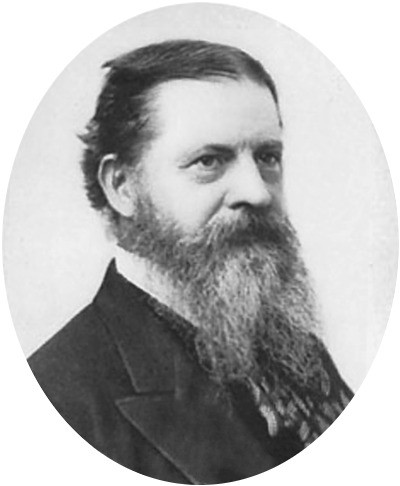 Charles Sanders Peirce (1839-1914)
Charles Sanders Peirce (1839-1914)
Charles Sanders Peirce (1839-1914) was a tormented, genius polymath who is best known today for his work in philosophy and logic that became his passion. He graduated summa cum laude from Harvard in chemistry and spent over 30 years as a research scientist at the US Coast Survey where he entered the field of gravimetrics, which developed into the central focus of his career there. At the time of his appointment Peirce knew very little about geodesy and gravimetric research but soon became a recognized authority in the field. He made significant contributions to the theory and practice of gravimetry and was the first to point out and demonstrate that the flexure of the pendulum stand introduced a serious error into gravimetric calculations. He felt that the pendulums in use in the Survey at the time were inferior, and so designed four pendulums designated Peirce Nos. 1, 2, 3, and 4. They were all invariable reversible pendulums of a type designed by Defforges in France. Pendulums Nos. 1, 2 and 4 were meter pendulums and No. 3 was a yard pendulum. They were all cylindrical in form with hemispherical ends, The reversibility of the pendulum required that one end be heavier than the other and, in order to attain this asymmetry with respect to weight with the cylindrical form, the compensating weights were placed within the cylinder. The Peirce No. 1 (meter) pendulum accompanied Greely to Fort Conger. The No. 2 (meter) pendulum and the No. 3 (yard) pendulum were swung together to determine the exact ratio of the meter to the yard, which was one of the major issues in metrology in the late 19th century. Peirce’s career at the Survey came to an ignominious end in 1891 when he was forced to retire on grounds of dereliction, largely because of long history of tardiness in the writing and submission of his reports, including that presenting the results from the Greely expedition.
Edward Israel
Sargent Edward Israel (1859-1884) was among the youngest members of the Lady Franklin Bay Expedition. He was born in Kalamazoo, Michigan and raised by his mother and father who were the first Jewish citizens of the village. After graduating from the University of Michigan, Israel was nominated by one of his professors for a position as astronomer on the Lady Franklin Bay Expedition. Before departing north at the age of 22, Israel received instructions directly from Peirce on how the Peirce No. 1 pendulum was operated. After meeting Peirce at the Coast Guard Survey Building on Capitol Hill in Washington DC, Israel was taken to the basement where he would gain his first glimpse of the instrument. The large brass cylinder that comprised the pendulum hung motionless in its large wooden frame until set in motion by its operator. It then made small, regular arcs as it rocked back and forth. Once at Fort Conger, Israel positioned the pendulum on the north side of the expedition house, anchored its wooden frame to cement piers, and enclosed it within a lean-to made of wood and canvas. Snow walls were likely built around the lean-to to stabilize temperature and reduce drafts. Winter was the ideal time for operating the pendulum as the severe cold stabilized the frame, and the frozen ground further stabilized the concrete piers. Israel swung his pendulum for 16 straight days in January of 1882 before packing the instrument up in its wooden box. Edward faithfully took a range of daily measurements with a variety of other instruments, including his magnetometer, theodolite, Perry transit, and sidereal chronometer. He slowly amassed immense tables of meteorological and astronomical data. In a later report, Greely wrote, “The records and computations made at Fort Conger by Sergeant Israel bear witness to his carefulness and conscientious performance of his duty.” Edward Israel would not survive the expedition, succumbing to starvation on May 27, 1884 at Cape Sabine. The pendulum he had painstakingly swung eventually became a rescue beacon, positioned on Stalknecht Island for search ships entering Smith Sound, before it was returned to Washington with the expedition's remaining members.


